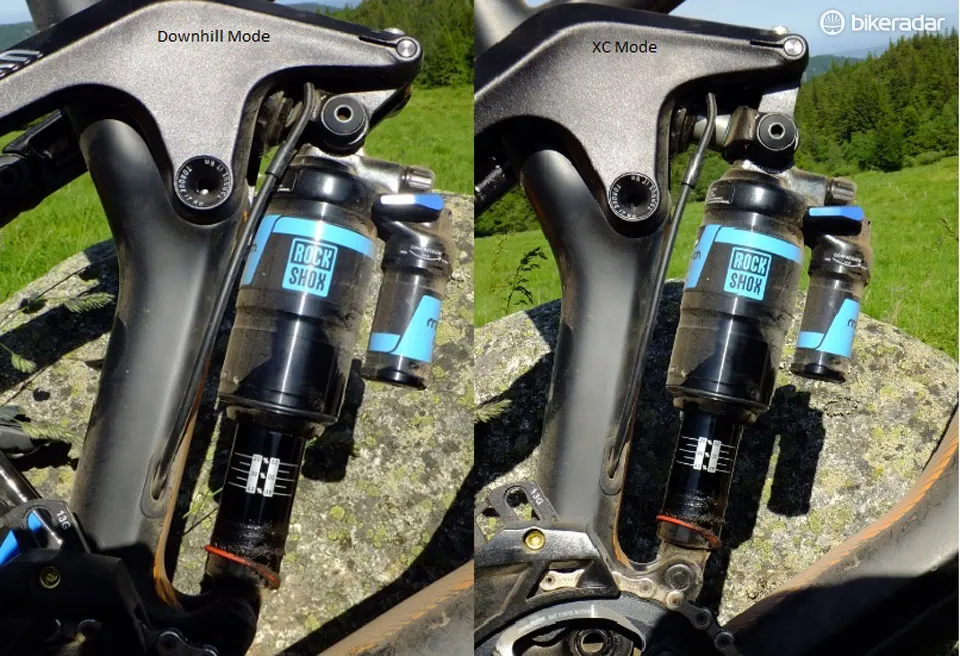When Canyon launched its latest enduro bike, the carbon Strive CF, on 12 June, the reveal was long awaited. All we knew about the bike was what we could guess from seeing team riders, such as Fabian Barel and Joe Barnes, riding heavily guarded prototypes that had cloth shrouds covering the suspension systems!
For the Strive CF, Canyon designed a new concept called ShapeShifter. It’s a relatively simple but effective way of adjusting geometry and suspension kinematics on the fly, switching between what Canyon calls XC and DH modes. Sadly the German brand isn't readily available in Australia, so for now it's just a look.
Having now had a chance to test ride the bike, this article was updated on 18 December to include the below video in which What Mountain Bike’s Jon Woodhouse and Tom Marvin chat about what’s surely one of 2014’s most interesting new bikes. The Strive CF will be reviewed in issue 169 of What Mountain Bike.
You’ll find all the original details about the Canyon Strive CF from the launch under the video.
Canyon strive cf first impressions
The ShapeShifter is a bar-operated mini-piston, which actuates a knuckle link just below the main rocker on the frame. This moves the shock backward or forward in relation to the rocker, adjusting its spring rate, the suspension system’s travel and the geometry of the bike. The piston is nestled between frame tubes and rocker linkages, and looks like it's well out of the way of mud, thanks to the plastic cover over the top. The piston only moves when actuated, so it shouldn’t cause too many maintenance issues, and Canyon reckons it only adds 200g to the weight of the bike.
In XC mode the Strive CF has 130mm of rear travel, which is relatively stiff compared to DH mode. Head and seat angles are, Canyon says, 1.5 degrees steeper (67.5 and 75 degrees, respectively) and the bottom bracket is around 20mm higher. This geometry makes the bike more suited to climbing, while the stiffer suspension reduces pedal bob. Canyon says that while some of the shocks offered on the bikes provide compression damping adjustment, it’s not really needed.

The ShapeShifter piston is hidden below the plastic cover. The green dot denotes the bike is in XC mode
Drop the bike into DH mode and the angles slacken to 66 degrees at the head tube and 73.5 degrees at the seat tubes, the bottom bracket drops, the suspension’s compression becomes softer and the rear wheel is able to travel through 160mm. The slacker angles, lower BB and softer but longer suspension mean the bike handles better in corners and high-speed sections.
Shifting between modes is easy once you’ve got the feel for the system. To activate DH mode, you press and hold the ShapeShifter lever and shift your weight back, pushing down with your heels before releasing the lever. To shift back to XC mode you press and hold the lever, shift your weight forwards and up, and release the lever. A green dial on the rocker tells you which mode you’re in. The system has no mid-point between modes, and the pressure in the piston can be adjusted a little to accommodate riders of different weight, or whether you want the system to fall more easily into XC of DH mode.

Side by side, DH and XC modes – the knuckle link is moved by the piston to alter the suspension's kinematics
The other interesting shift is that Canyon now has seven different frames on offer. In the UK, we’ve been calling out for longer bikes from Canyon – in What Mountain Bike magazine’s Trail Bike of the Year awards, the shortness of Canyon's contender held it back a touch in the standings. Canyon is now offering four standard frame sizes (S, M, L, XL) and three ‘pro’ sizes (S, M, L); the only difference is that the pro models have a longer top tube. For example, the standard medium frame has an effective top tube length of 600mm, while the Pro version has a 629mm effective top tube length.
The rest of the Strive CF’s features come as no surprise, and showcase Canyon’s usual attention to detail. The tapered steerer gives way to a down tube that holds the internally routed cables. Towards the bottom of the down tube there’s a plastic down tube protector to reduce the chance of rock-strikes damaging the frame. This is removable to give better access to the internally routed cables, which is a nice touch. It's good to see a chainsuck plate and bolt-through rear axle too, as well as the ISCG05 chainguide mount.
The Strive CF range goes on sale today, with delivery expected in early August. The information we have suggests that the range will start at €3,699 for the Strive CF 8.0 Race (with the pro geometry), which comes with a 160mm travel Rockshox Pike RCT3 fork and a Monarch Plus RC3 Debon Air shock, a SRAM X01 groupset with RaceFace Turbine cranks, SRAM Roam 40 wheels, RockShox Reverb Stealth seatpost and a mixture of RaceFace, Ergon and Renthal finishing kit.
The top-of-the-line Strive CF 9.0 SL costs €4,999 and comes with the new 170mm Fox 36 fork, a Cane Creek DBinline shock, Shimano XTR groupset, Mavic Crossmax XL wheels and a smattering of Canyon’s own carbon finishing kit.
The bike in the gallery is the Strive CF 9.0 Race with the pro geometry, and is priced at €4,299. None of these models are currently available to Australian buyers.











